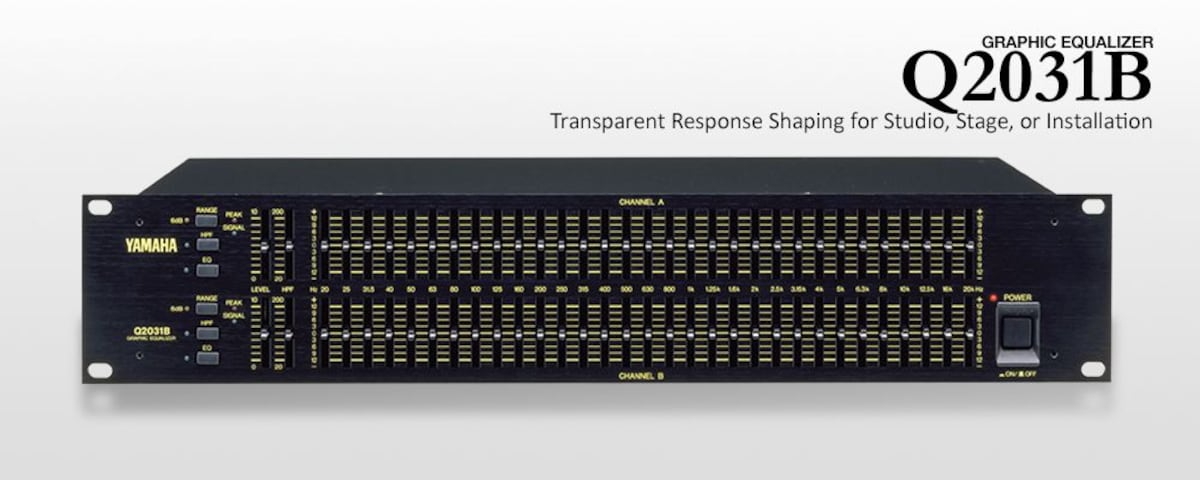Q2031B Graphic Equalizer Discontinued
Versatile EQ Control
Yamaha graphic equalizers incorporate active filters to provide minimum phase shift and smooth response at any boost or cut setting. The Q2031B offers 31 equalization bands at 1/3 octave intervals from 20Hz to 20kHz.
Range Switches
Switchable EQ gain of +/- 6dB or +/-12dB provides with a broad range, or a narrow, more precise scope of control. The +/-12dB range offers wide-range control, essential for broad range tonal variation or feedback control. The +/-6dB range provides fine control within a narrower range, well suited for acoustic tuning and subtle response shaping.
2-Channel Configurations
With synthesizers, signal processors, and other equipment offering stereo output as the rule, the Q2031B provides 2-channel versatility in single unit designs. The 2U-size Q2031B offers completely independent 2-channel control from input to output with separate 31 band equalization and variable high pass filters for each channel.
Outstanding Audio Performance
A graphic equalizer's main function is to shape sound, without adding unwanted distortion or noise. The Q2031B provides quiet operation with less than 0.05% total harmonic distortion; noise is kept to a minimum with levels better than -96dB. Yamaha equalizers supply smooth, natural sound that is even compatible with digital sources.
Variable High Pass Filters
High pass filters are extremely useful in fighting against low-end boominess, AC hum, wind noise and preventing subsonic components from muddying the sound as well as wasting amplifier power. The Q2031B incorporates continuously variable high pass filters on both equalization channels. Providing 12dB of octave rolloff below the desired frequency, the filters can be independently adjusted with sliders, to any frequency between 20Hz to 200Hz.
Balanced Input/Output
Signal input and output is provided by both balanced 1/4" phone jacks and balanced XLR jacks, all rated at +4dB. This gives an In/Out interface that can be easily connected to other types of equipment.
Peak Indication and Muting
Independent peak indicators, to warn of excessively high signal levels, light when the output signal reaches 3dB below clipping. An automatic muting circuit mutes the equalizer's output for approximately 3 seconds after the power is switched on, to prevent transients from damaging amplifiers and speaker systems.
EQ Bypass
EQ ON/OFF switches provide easy EQ bypass and instant comparison between equalized and unequalized sound. LED indicators let you know when the EQ is on.
Rugged 19" Rack Mountable Design
The Q2031B is ruggedly constructed to withstand the rigors of use on the road, and can be mounted in any standard 19-inch rack.
19" Rack Mountable
The Q2031B can be mounted in any standard 19 inch rack.
Acoustic Tuning
Use graphic qualization to fine tune any sound system to match the acoustics of a studio, concert hall, or any other sound environment. It can also be utilized to compensate for serious acoustic irregularities found in rooms that were not designed for music listening and keep properly designed studios or halls at their optimum sound level.
Feedback Control
In situations where restrictions make a feedback proof setup impossible, Yamaha graphic equalizers can be used to reduce the gain of problem frequencies, thus minimizing the possibility of sudden outburst of feedback that can ruin a performance.
Sound Shaping
Yamaha graphic equalizers are also creative tools that can shape the tone of the instrument or voice to achieve a better blend in the mix. When added to reverb, EQ can electronically simulate a wide range of acoustic environments.
Noise Suppression
Graphic equalization can effectively minimize tape hiss, stage rumble, wind noise, microphone popping, excessive sibilance and other sources of unwanted noise.







